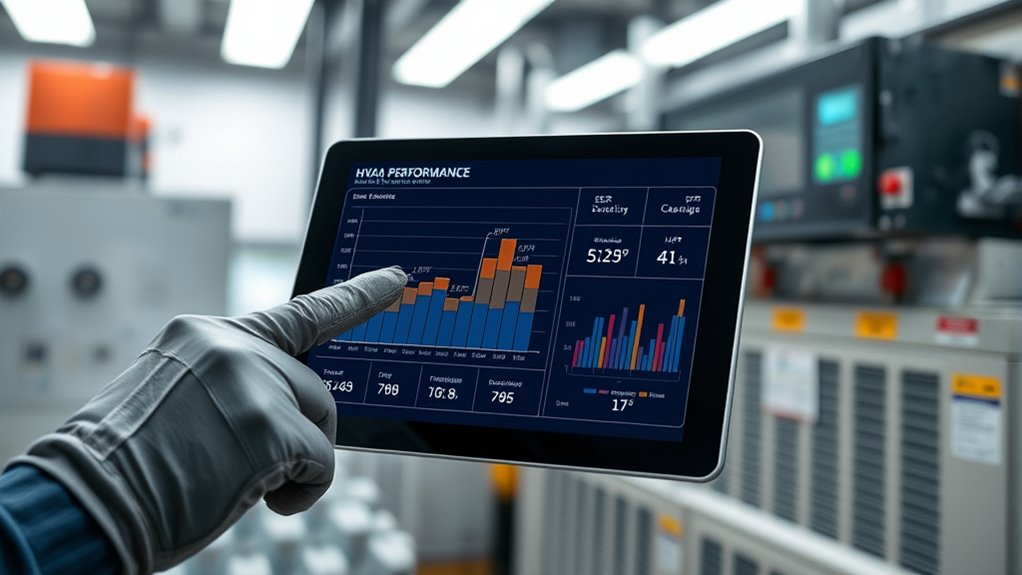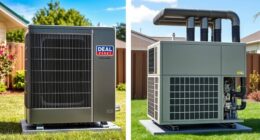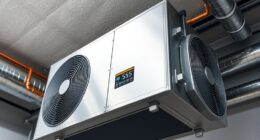Understanding SEER, HSPF, and other HVAC metrics helps you evaluate energy efficiency and system performance. SEER measures cooling efficiency, while HSPF assesses heating efficiency for heat pumps. Higher ratings mean lower energy bills and better savings. It’s crucial to match these ratings with proper system sizing for maximum comfort and efficiency. If you want to learn how these metrics affect your home’s comfort and savings, you’ll find useful insights ahead.
Key Takeaways
- SEER measures cooling efficiency by dividing cooling output by energy used during a season; higher values mean better efficiency.
- HSPF assesses heat pump heating efficiency based on heat output versus energy consumption; higher ratings indicate greater performance.
- These ratings are indicators of system energy savings, helping compare units for cost-effective operation.
- Proper HVAC sizing, based on load calculations, ensures high-rated units operate efficiently and meet home needs.
- Combining high performance ratings with correct sizing optimizes system longevity, cost savings, and overall comfort.

Ever wondered how HVAC systems are assessed to guarantee they’re operating efficiently? The answer lies in understanding performance metrics like SEER, HSPF, and others. These numbers aren’t just technical jargon; they’re essential indicators that help you determine how well your system is performing in regard to energy efficiency and system capacity. When shopping for a new air conditioner or heat pump, these metrics guide you toward units that will save you money and keep your home comfortable.
Energy efficiency is at the core of these ratings. SEER, or Seasonal Energy Efficiency Ratio, measures the cooling output during a typical cooling season divided by the total electrical energy used in that period. A higher SEER means your AC uses less electricity to produce the same amount of cooling, translating to lower energy bills. Similarly, HSPF, or Heating Seasonal Performance Factor, evaluates the efficiency of heat pumps in heating mode. It considers how much heat the system produces relative to the energy it consumes over a season. A good HSPF rating indicates a heat pump that maximizes energy efficiency during colder months, reducing your overall heating costs.
Higher SEER and HSPF ratings mean greater energy efficiency and lower utility bills for cooling and heating.
But understanding these metrics isn’t just about saving money—it’s also about making sure your HVAC system has the appropriate system capacity. System capacity refers to the ability of your unit to meet your home’s heating or cooling needs without overworking or underperforming. An undersized system will struggle to maintain comfort and may cycle on and off frequently, wasting energy and causing wear and tear. Conversely, an oversized unit might turn on and off too often, leading to inefficiency and humidity issues. Properly matching system capacity to your home’s size and insulation levels guarantees top performance, longevity, and energy efficiency.
Manufacturers often advertise high SEER and HSPF ratings, but these numbers need to be interpreted within the context. A system with an excellent rating that’s too large for your space isn’t beneficial—it’ll waste energy and cost more upfront. On the other hand, a smaller, efficient unit that matches your home’s needs can deliver comfort while running economically. That’s why a proper assessment involves evaluating both the efficiency ratings and the system capacity, often through professional load calculations. These calculations help determine the right size and efficiency level for your specific home, ensuring you get the best performance and energy savings.
Additionally, understanding how these metrics relate to actual system performance helps you make informed decisions when upgrading or installing HVAC equipment. Proper sizing and efficiency ratings work together to optimize your system’s operation, saving money and extending its lifespan.
In short, understanding HVAC performance metrics like SEER and HSPF empowers you to make smarter choices. They reveal how well a system will perform regarding energy efficiency and whether it has the right capacity for your home. When combined with proper sizing and professional assessment, these metrics help you select an HVAC system that’s reliable, cost-effective, and tailored to your comfort needs.
Frequently Asked Questions
How Do I Compare HVAC Units With Different SEER and HSPF Ratings?
To compare HVAC units with different SEER and HSPF ratings, focus on their energy efficiency, which directly impacts your energy bills. Higher ratings mean better efficiency, saving you money over time. For cost comparison, consider both the initial purchase price and long-term savings from lower energy consumption. Choose a unit that offers the best balance of high efficiency and affordability, ensuring you get the most value for your investment.
Are Higher SEER and HSPF Ratings Always More Cost-Effective?
Higher SEER and HSPF ratings generally lead to better energy savings, making them more cost-effective over time. They reduce your utility bills and lessen environmental impact by consuming less energy. However, the upfront cost might be higher, so you should weigh the initial investment against long-term savings. If you prioritize energy efficiency and environmental responsibility, choosing units with higher ratings can be a smart, cost-effective decision.
Do Regional Climate Differences Affect HVAC Performance Metric Importance?
In warm, sunny climate zones, energy efficiency becomes your best friend, making high SEER and HSPF ratings more valuable. Your regional climate influences how important these metrics are, with colder zones prioritizing heating efficiency. Think of your climate zone as the stage setting for your HVAC system’s performance—selecting equipment suited to your environment guarantees you get the most comfort and savings, no matter the weather outside.
How Often Should I Evaluate My HVAC System’s Performance Metrics?
You should evaluate your HVAC system’s performance metrics at least once a year, ideally during seasonal checkups. Incorporate a maintenance schedule that includes inspecting and tuning your system to guarantee peak efficiency. Regular assessments help you catch issues early, maintain energy savings, and prolong equipment lifespan. Don’t wait until problems arise—consistent performance evaluations keep your system running smoothly and efficiently year-round.
Can I Improve My Existing System’s SEER or HSPF Ratings?
Like a trusty steed from a bygone era, your current HVAC system can still be improved. You can boost its energy efficiency by upgrading to newer equipment with higher SEER or HSPF ratings. Consider consulting an HVAC professional to evaluate options, such as installing a more efficient compressor or ductwork enhancements. These upgrades help your system perform better, save energy, and keep your home comfortable all year long.
Conclusion
By mastering SEER, HSPF, and other HVAC metrics, you’ll reveal the secret codes to ultimate energy savings and indoor comfort. Think of it like wielding a superhero’s power—saving tons on bills while making your home feel like a luxurious oasis. Don’t settle for average; dive deep into these metrics and transform your HVAC system into an unstoppable, efficiency-driving machine. The future of perfect climate control is just a metric away—are you ready to unlock it?








